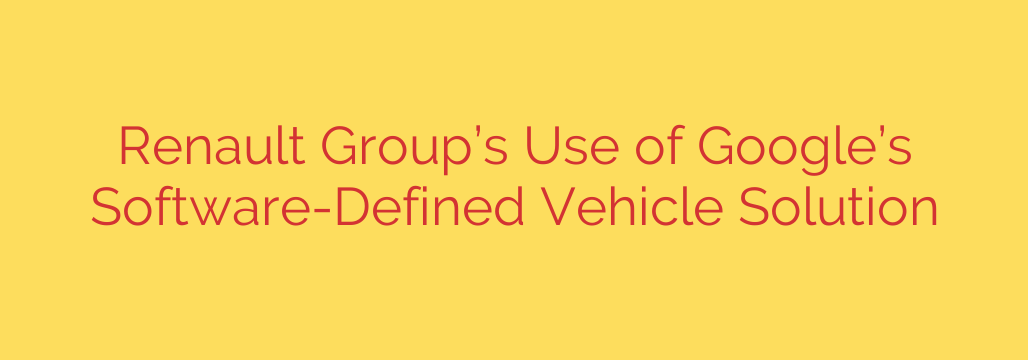
Renault and Google Are Redefining the Automobile: Welcome to the Software-Defined Era
The car sitting in your driveway is more than just an engine, four wheels, and a chassis. For decades, vehicles have been evolving, integrating more and more computers to manage everything from fuel injection to entertainment systems. But we are now on the cusp of the most significant automotive revolution in a century, and it’s being driven by software.
Leading this transformation, Renault Group is collaborating with Google to build its next generation of vehicles on a “Software-Defined Vehicle” (SDV) platform. This isn’t just about a bigger touchscreen or better navigation; it’s a fundamental rethinking of what a car is and what it can become.
What Exactly is a Software-Defined Vehicle?
Think of your smartphone. You buy the hardware once, but its capabilities are constantly evolving. App updates add new features, security patches fix vulnerabilities, and operating system upgrades can completely refresh the user experience. The Software-Defined Vehicle applies this exact same logic to your car.
In an SDV, functions that were once controlled by fixed, unchangeable hardware are now managed by flexible, updatable software. This software-first approach decouples the car’s features from its physical components, allowing automakers to add value, enhance performance, and improve safety long after the car has left the factory floor. The key enabler for this is over-the-air (OTA) updates, which deliver new software directly to the vehicle wirelessly.
A Glimpse into the Future: The Power of Collaboration
To build this ambitious vision, Renault Group is leveraging Google’s extensive expertise in software, cloud computing, and artificial intelligence. This partnership creates a powerful foundation for the car of the future, built on several key pillars:
- Android Automotive OS: This is the core operating system for the vehicle, providing a familiar, intuitive, and highly customizable in-car experience.
- Google Cloud: This robust cloud infrastructure is used for immense data processing and storage, powering everything from advanced AI applications to the vehicle’s “digital twin.”
The most revolutionary concept in this collaboration is the creation of a comprehensive digital twin for each vehicle. This is a highly advanced, real-time virtual replica of the physical car that exists in the cloud. This digital doppelgänger collects data from the car’s sensors and systems, allowing for continuous analysis and improvement.
What This Means for You, the Driver
This technological shift isn’t just for engineers—it will directly and dramatically improve the ownership experience. Here’s how:
- A Car That Gets Better Over Time: Your vehicle will receive regular OTA updates, just like your phone. This means gaining access to new infotainment features, improved battery management for EVs, or even enhanced driver-assistance capabilities without ever visiting a dealership.
- Predictive Maintenance: By analyzing data through its digital twin, your car can predict when a component might fail before it actually happens. Imagine getting an alert that says, “Your battery’s health is declining. We recommend scheduling a service in the next 30 days.” This proactive approach enhances reliability and prevents unexpected breakdowns.
- A Truly Personalized Experience: The vehicle will learn your preferences, from cabin temperature and seating position to commonly used apps and navigation routes. It will create a driving environment that is uniquely yours.
- New On-Demand Services: This platform opens the door for a new ecosystem of in-car applications and services. This could include everything from advanced diagnostics apps to productivity tools and entertainment subscriptions that you can activate or deactivate as needed.
Security in a Constantly Connected World
As vehicles become more connected, cybersecurity becomes paramount. A software-defined architecture offers a significant advantage here. Security vulnerabilities can be identified and patched rapidly via over-the-air updates, drastically reducing the window of risk compared to traditional vehicle recall processes.
However, as a driver of a connected car, it’s wise to remain security-conscious. Here are a few essential tips:
- Always Install Updates: Treat vehicle software updates with the same urgency as you do for your phone or computer. They often contain critical security fixes.
- Use Strong Passwords: For any associated mobile app or owner account, use a strong, unique password and enable two-factor authentication if available.
- Be Mindful of In-Car Apps: Only download and install applications from the official, manufacturer-approved app store to avoid malware.
- Review Privacy Settings: Understand what data your vehicle is collecting and sharing. Modern systems offer granular controls to manage your privacy.
The era of the static, unchanging vehicle is over. By embracing a software-defined future, Renault is not just building a better car—it’s creating an intelligent, evolving platform on wheels that is safer, more personal, and continuously improving.
Source: https://cloud.google.com/blog/products/application-development/renault-groups-software-defined-vehicles-built-on-google-cloud/








